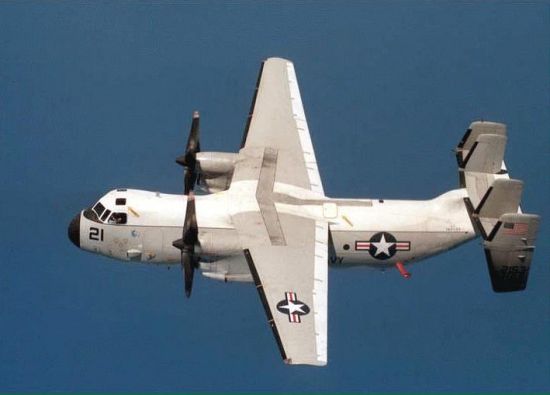|
||||||||||
|
|
||||||||||
|
||||||||||
|
|
||||||||||
 - -
|
|

|
Grumman C-2 Greyhound Carrier Onboard Delivery Transport |
|
DESCRIPTION:
Based on the success of the E-2 Hawkeye AEW aircraft, Grumman proposed a carrier onboard delivery (COD) derivative to transport vital supplies or personnel between ships at sea and distant shore bases. Such an aircraft allows the carrier battle forces to remain at peak operability even when too far from shore for supplies to be ferried by helicopter. Once the US Navy accepted the design, Grumman began production of 19 aircraft. These planes differ from the E-2 in the deletion of the rotating radome, having a larger diameter fuselage, addition of rear cargo doors, strengthening of the fuselage deck for heavy loads, and elimination of the tailplane dihedral made necessary by the radome installation. The resulting wider and deeper fuselage provides space for up to 39 troops or personnel, 20 stretchers and attendants, or 10,000 lb (4,535 kg) of cargo pallets. The initial 19 C-2 aircraft supplemented the older C-1 Trader in the COD role until the mid-1980s when the Navy ordered an additional 39 C-2A Greyhounds. This second batch of aircraft was based on the updated E-2C airframe and incorporated updated avionics and engines as well as improved passenger accomodations. While the older C-2s were withdrawn from service by 1987, those of the second batch remain in use, and two C-2 Greyhounds equip each carrier air wing. Plans had called for the C-2 to be replaced by a new plane called the Common Support Aircraft, but that effort appears to have been shelved. The C-2 will likely remain in service until at least 2020.
Last modified 21 February 2011
|
|
| HISTORY: | |
| First Flight | 18 November 1964 |
|
Service Entry
|
December 1964
|
| CREW: |
four: pilot, co-pilot, crew chief, loadmaster
|
| PASSENGERS: |
up to 39 troops, up to 20 stretchers and 4 nurses
|
|
ESTIMATED COST:
|
$39 million
|
| AIRFOIL SECTIONS: | |
| Wing Root | NACA 63A216 |
|
Wing Tip
|
NACA 63A414
|
| DIMENSIONS: | |
| Length | 57.56 ft (17.54 m) |
| Wingspan | 80.58 ft (24.56 m) |
| Height | 16.92 ft (5.16 m) |
| Wing Area | 700.0 ft² (65.03 m²) |
|
Canard Area
|
not applicable
|
| WEIGHTS: | |
| Empty | 31,155 lb (14,130 kg) |
| Normal Takeoff | unknown |
| Max Takeoff | 54,355 lb (24,655 kg) |
| Fuel Capacity | unknown |
|
Max Payload
|
10,000 lb (4,535 kg) [ship operation] 15,000 lb (6,805 kg) [land operation] |
| PROPULSION: | |
| Powerplant | two Allison T56-425 turboprops |
| Thrust |
9,820 ehp (7,322 kW)
|
| PERFORMANCE: | |
| Max Level Speed |
at altitude: 390 mph (625 km/h) at sea level: unknown cruise speed: 300 mph (480 km/h) |
| Initial Climb Rate | unknown |
| Service Ceiling | 33,500 ft (10,210 m) |
| Range |
typical: 1,300 nm (2,410 km) ferry: 1,565 nm (2,900 km) |
| g-Limits |
unknown
|
| ARMAMENT: | |
| Gun | none |
| Stations | none |
| Air-to-Air Missile | none |
| Air-to-Surface Missile | none |
| Bomb | none |
| Other |
none
|
| KNOWN VARIANTS: | |
| C-2A | Initial production model similar to the E-2 but with a larger diameter fuselage and lacking the radome; 19 built |
| C-2A |
Despite the identical designation, this second batch is based on the E-2C model and includes more powerful
engines, updated avionics, improved corrosion protection, installation of an auxiliary power unit, and
better passenger comfort; 39 built
|
|
KNOWN COMBAT RECORD:
|
Vietnam War (USN, 1965-1972) Iraq - Operation Desert Storm (USN, 1991) Afghanistan - Operation Enduring Freedom (USN, 2001-present) Iraq - Operation Iraqi Freedom (USN, 2003-present) |
|
KNOWN OPERATORS:
|
United States (US Navy)
|
|
3-VIEW SCHEMATIC:

|
|
SOURCES:
|
|


|
Aircraft | Design | Ask Us | Shop | Search |

|
|
| About Us | Contact Us | Copyright © 1997- | |||
|
|
|||